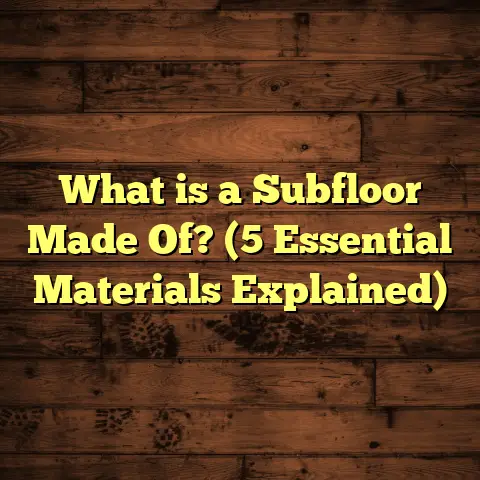What is the Cost of Installing Laminate Flooring? (5 Key Factors)
“Laminate flooring offers an affordable and durable option for homeowners,
but the costs can vary widely depending on several factors.”
— Mark Thompson, Flooring Industry Expert
Hey, I’m really glad you want to know more about laminate flooring
costs. Over the years, I’ve installed floors in all kinds of homes,
from tiny apartments to sprawling family houses, and I’ve learned
that understanding what affects the price makes a huge difference.
I’ll share what I know from hands-on experience, technical details,
and some stories that might help you avoid costly mistakes.
What Exactly Is Laminate Flooring?
You might have heard about laminate flooring but wonder what it really is.
Here’s a simple way to think about it: laminate is a man-made flooring product
that mimics the appearance of real wood or stone but is built differently.
This material is made up of several layers pressed and bonded together under
heat and pressure. Each layer serves a different purpose.
Breaking Down the Layers
- Wear Layer: This is the top surface you walk on. It’s clear and very tough,
designed to resist scratches, stains, and daily wear. Usually made from melamine resin.
The thickness of this layer makes a huge difference in durability. For instance,
a 12-mil wear layer lasts longer than an 8-mil one. - Design Layer: Right below the wear layer is a photographic film that gives
laminate its look. Using advanced printing technology, manufacturers create high-resolution
images that look like wood grain, stone textures, or even abstract patterns. - Core Layer: This is typically high-density fiberboard (HDF) or medium-density fiberboard (MDF).
It provides stability and strength to the plank. HDF is denser and more resistant to moisture than MDF,
which means it’s less likely to swell or warp over time. - Backing Layer: The bottom layer protects against moisture from below and adds balance to prevent warping.
How Is Laminate Made?
The manufacturing process involves impregnating layers of paper with resins and bonding them at high temperature and pressure. Here’s a quick overview:
- Impregnation: Decorative paper is soaked in melamine resin to harden it.
- Layer Stacking: The wear layer, design layer, core board, and backing layer are stacked.
- Pressing: The stack is compressed in a hydraulic press at temperatures around 300°F (150°C) and high pressure.
- Cutting & Finishing: After cooling, planks are cut to size and edges are beveled or shaped for easy installation.
This process creates a rigid plank that’s tough enough for residential and commercial use.
Why Choose Laminate?
People often pick laminate because it’s more affordable than hardwood but still looks great. It’s also easier to install with click-lock systems, making it popular for DIY projects. Plus, it resists dents and scratches better than many natural wood floors.
1. Material Quality: What Drives the Price of Laminate Boards?
I’ve noticed that the cost of laminate planks varies widely — sometimes it’s hard to believe two products look so similar but have vastly different prices.
What Makes One Plank More Expensive?
- Wear Layer Thickness: This top protective layer varies from about 6 mils (thinner) to 20 mils (thicker). A thicker wear layer means better scratch resistance and longer life.
- Core Material: HDF cores are more durable than MDF but cost more.
- Design Quality: Some laminates use advanced embossing techniques that make textures feel real.
- Brand & Warranty: Top brands offer longer warranties (up to 25 years residential) which often means better quality control.
- Special Features: Some laminates include UV protection to prevent fading or have enhanced moisture resistance.
Price Range
- Budget laminate: $0.80 – $1.50 per sq.ft.
- Mid-range laminate: $1.50 – $2.50 per sq.ft.
- Premium laminate: $2.50 – $3.50+ per sq.ft.
Personally, I’ve found mid-range laminates offer the best value for durability and looks unless you’re after a very specific feature like waterproofing.
My Story About Material Quality
A few years back, I installed laminate flooring for a couple who wanted an affordable alternative to hardwood. They picked a very cheap laminate at $0.85/sq.ft. Initially, it looked great. But within 18 months, the surface started peeling in spots where furniture was moved around often.
When they called me back for repairs, I recommended upgrading to a laminate with a thicker wear layer—around 12 mils—and an HDF core.
We replaced their floor with mid-range boards costing nearly double per sq.ft., but the new floor has lasted over five years now with zero issues.
2. Installation Labor: What Does It Actually Cost?
Labor pricing depends on your location and the job’s complexity. When I estimate labor for installing laminate floors, I consider:
- Room Size & Shape: Larger rooms usually reduce per sq.ft labor cost due to economies of scale.
- Subfloor Condition: Uneven or damaged subfloors add prep time.
- Removal of Old Flooring: Taking up carpet, vinyl or tile can be labor-intensive.
- Layout Complexity: Diagonal patterns or multiple cuts increase labor hours.
- Baseboards & Trims: Removing and reinstalling baseboards takes extra time.
Typical Labor Rates
Labor rates generally range from $1.50 to $3.00 per sq.ft., but in high-cost cities like New York or San Francisco, rates can hit $4 or more.
Common Challenges That Increase Labor
On one job in an older home, I discovered the subfloor was uneven with dips over half an inch across several feet. To fix it, I had to apply self-leveling compound which took two days to dry before installing laminate.
This prep work almost doubled labor costs compared to a straightforward install on a flat plywood subfloor.
Personal Installation Tip
If you’re planning on DIY installation, take time to learn proper underlayment placement and how to stagger plank seams for strength and aesthetics. Mistakes here can lead to squeaky floors or premature plank failure.
3. Subfloor Preparation: Why This Step Matters More Than You Think
The subfloor is the foundation your laminate rests on. No matter how good your planks are or how skilled the installer is, if the subfloor isn’t right, problems will appear:
- Uneven Surfaces: Can cause creaks and gaps.
- Moisture Problems: Can cause swelling or mold growth.
- Damage or Rot: Needs repair before flooring goes down.
What Does Subfloor Prep Include?
- Cleaning debris and old adhesive
- Repairing damaged plywood or concrete cracks
- Leveling uneven surfaces using patching compounds
- Installing moisture barriers if needed
Costs Involved
Depending on condition:
- Minor cleanup and sanding: $0.50 – $1 per sq.ft.
- Moderate leveling or patching: $1 – $2 per sq.ft.
- Major repairs or replacement: $2+ per sq.ft.
A Case Study on Subfloor Prep Costs
I once worked on a basement renovation where moisture was a big issue. The concrete slab had damp patches that needed sealing with an epoxy moisture barrier before laying down underlayment and laminate.
This prep added about $1.75 per sq.ft. to costs but prevented future warping and mold issues — saving headaches down the road.
4. Additional Materials: Little Extras That Add Up
Besides planks and labor, don’t forget these materials:
Underlayment
Almost every laminate floor needs some kind of underlayment beneath it:
- Provides sound insulation
- Adds cushioning for comfort
- Acts as moisture barrier in some cases
Prices vary:
- Basic foam underlayment: $0.25 – $0.40 per sq.ft.
- Premium cork or felt: $0.50 – $0.70 per sq.ft.
- Specialized moisture barrier underlayment: up to $1 per sq.ft.
Moldings & Transitions
Where laminate meets other flooring types or walls you’ll need transition strips or molding pieces:
- T-molding (between two floors): $2 – $5 per linear foot
- Reducer molding (for height differences): $2 – $4 per linear foot
- Quarter round/base shoe molding: $1 – $3 per linear foot
Adhesives & Tools
Most modern laminates use click-lock systems needing no glue but some still require adhesive along edges or trims.
You’ll also need spacers for expansion gaps and possibly a tapping block and pull bar for installation—usually minor costs around $20-$50 total.
How FloorTally Helps Me With These Calculations
Estimating all these materials plus waste can get complicated fast.
That’s why I use FloorTally—it lets me enter room dimensions, pick materials, add waste factors (usually 5%-10%), include labor rates by region, and factor in extras like underlayment and moldings all in one place.
It saves me hours of manual math and gives clients clear cost breakdowns upfront so they can plan budgets realistically without surprises.
5. Regional Pricing Variations: Why Where You Live Changes Everything
I’ve done projects coast-to-coast and noticed prices vary widely depending on geography:
- Urban vs Rural: Big cities have higher labor costs due to living expenses.
- Climate Impact: Wet climates sometimes require special moisture barriers increasing costs.
- Local Supply Chains: Availability of certain brands or materials can affect pricing.
- Demand & Competition: Areas with many installers might offer better labor deals.
For instance, installing laminate in Los Angeles might cost 30% more than in a small Midwest town because workers’ hourly rates differ significantly.
Extra Stories From My Work Across Regions
In Florida, I handled an installation where humidity was so high we had to specify laminate with enhanced moisture resistance plus thicker vapor barriers underneath—adding about 20% more cost compared to standard laminate jobs I do in drier areas like Arizona.
Waste Factor: How Much Extra Material Should You Order?
One detail many people overlook is waste factor—the percentage of extra material needed beyond your room’s square footage due to cutting errors, pattern matching, or mistakes.
I always recommend ordering 5%-10% more laminate than your exact measured area:
- Straight layouts usually need around 5% extra.
- Complex patterns or diagonal installs might require up to 10%.
Buying too little material is expensive because you may need to reorder batches that don’t exactly match color or production runs later on.
Laminate Flooring Longevity & Maintenance Costs
You might wonder if spending more upfront saves money later on maintenance:
- Higher quality laminates with thick wear layers resist scratches better.
- Proper installation reduces chances of warping or gaps.
- Using recommended cleaning products extends life; avoid wax-based cleaners which damage wear layers.
In my experience servicing floors years after installation, clients with mid-to-high grade laminates often avoided costly repairs or replacements for at least 10 years.
Frequently Asked Questions About Laminate Flooring Costs
Is laminate cheaper than hardwood?
Yes, generally by about 30%-50%, depending on the type of wood you compare it with.
Can laminate be installed in bathrooms?
Some newer waterproof laminates work well in bathrooms but most traditional laminates don’t handle standing water well.
Do I need professional installers?
It depends—DIY saves money but professional installers bring expertise that reduces mistakes and improves floor longevity.
Summary of Cost Ranges Per Square Foot
| Item | Low Range | High Range | Notes |
|---|---|---|---|
| Laminate Material | $0.80 | $3.50 | Depends on quality & brand |
| Labor | $1.50 | $4.00 | Varies by region & complexity |
| Subfloor Prep | $0.50 | $2.50 | Condition dependent |
| Underlayment | $0.25 | $1.00 | Basic foam vs advanced types |
| Moldings/Transitions | $1 | $5 (per lf) | Needed at edges & doorways |
Wrapping Up With Some Practical Advice
If you’re thinking about installing laminate flooring:
- Measure your space carefully — include closets or hallways if applicable.
- Decide on quality level based on budget and expected wear.
- Don’t skip subfloor inspection — fix problems early.
- Factor in labor realistically—ask for multiple quotes if hiring pros.
- Use tools like FloorTally for detailed estimates before buying materials.
- Order extra material for waste — better safe than sorry.
- Consider long-term maintenance costs—not just upfront price.
That covers everything from what laminate really is to detailed cost factors
and real-world examples from my work over the years.
If you want me to help you figure out your project specifics or need advice
on choosing materials or installers near you, just ask!
Would you like me to walk you through how to calculate your own project cost step by step using FloorTally? Or maybe you want tips on DIY installation tricks? Let me know!





